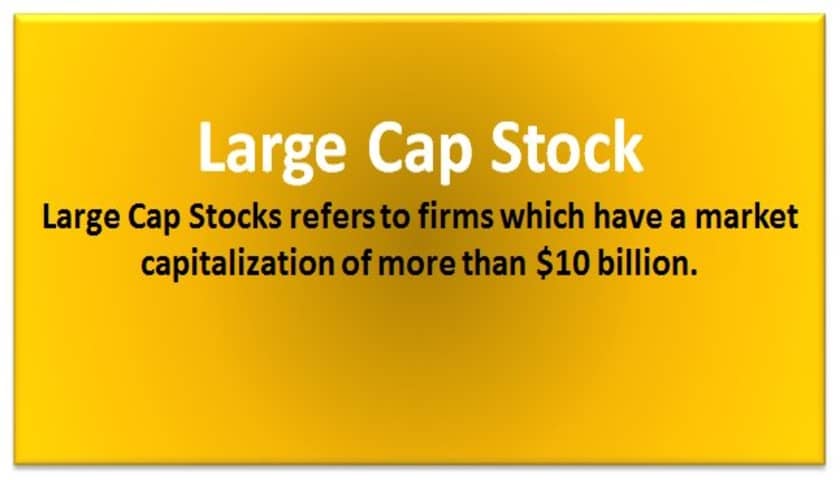What Does “Large Cap” (also known as “Big Cap”) Mean?
A corporation having a market capitalization of more than 20,000 crores is referred to as a large-cap (or “big cap”). The term “big market capitalization” is abbreviated as “large-cap.” The market capitalization of a corporation is derived by multiplying the number of outstanding shares by the stock price per share. During unstable markets, large-cap stocks tend to be less volatile as investors seek quality and stability and become more risk-averse.
The stock of a corporation is classed as large-cap, mid-cap, or small-cap.
Small-Cap companies – below Rs. 5000 crore
Mid-Cap companies – Rs. 5000 – 20,000 crore
Large-Cap companies – Above Rs. 20,000 crore
Names like Apple (AAPL), Berkshire Hathaway (BRK.A), and Exxon Mobil (XOM) make up over 90% of the American stocks market (XOM). Many indices and benchmarks, such as the Dow Jones Industrial Average (DJIA) and the Standard and Poor’s 500, track large-cap firms (S&P 500). Because large-cap companies account for the vast majority of the stock market in the United States, they are frequently considered essential portfolio investments.
Characteristics of Large-Cap Stocks-
The following are some of the characteristics of large-cap stocks:
-
Reasonable Returns:
Large-cap corporations have been around for a long time and have reached financial maturity. As a result, their stock prices cannot rise as quickly as those of mid-cap and small-cap companies. The dividend component of such equities provides the majority of the returns.
-
Low-risk:
Large-cap corporations have a strong financial infrastructure, as well as financial strength and soundness. As a result, large-cap stocks have a modest reaction to market volatility. It reduces the risk of such investments greatly because, unlike mid-cap and small-cap companies, they are not at risk of going bankrupt during a market downturn and can continue to operate.
-
History abounds:
Companies on the list of large-cap stocks have been in operation for a long time. They have a long operational history that is accessible to the general public through multiple ways, which instils confidence. Potential investors might utilize it to conduct research.
-
Costly:
In most situations, these equities are more expensive than other investment possibilities.
-
Liquid:
Because of their enormous popularity and readily available purchasers, they are the most liquid investment choices on the market.
Why Should You Invest in Large Cap Stocks?
-
Stability in Large-Cap Companies-
The most significant benefit of including large-cap stocks in your investment portfolio is the added stability they can bring. Because large-cap firms are so huge and have such a strong customer reputation, they are less likely to face a commercial or economic situation that renders them bankrupt or causes them to cease revenue-generating operations entirely. Small- and mid-cap companies do not have the same amount of stability as large-cap companies, and hence entail a higher level of risk.
-
Dividend Recipients
Another benefit of investing in large-cap firms is the possibility of receiving consistent dividend payments. Because large-cap companies are already well-established in the market, their stock values are not normally expected to expand at high rates over time. This can result in a stock price that remains stagnant and little to no capital appreciation for investors.
Despite the lack of quick stock price increase, large-cap firms frequently issue dividends to compensate shareholders. When these dividends are factored into the performance calculation over time, they can result in outstanding total returns for large-cap investors. Large-cap stocks that provide consistent dividends are popular among income investors and those seeking to supplement their income.
-
Valuation and research
Investors and creditors can easily access research on large-cap firms’ operations and profitability levels because they frequently have a long business tenure. Large-cap public corporations are expected to present accurate and timely financial statements to shareholders and potential investors, making it easier to determine whether a company is worth investing in.
In addition to studies, appropriate valuation can be determined by combining company history and financial data with current business investment. These factors are crucial in determining the risk and potential benefit of investing in a large-cap firm.
The Russell 1000 Index, which includes around 1,000 of the largest companies by market capitalization operating in the United States, can be used by investors to locate and assess large-cap companies. Large-cap investments can be purchased as individual stock shares, via an exchange-traded fund (ETF) that tracks a large-cap benchmark, or through one of the hundreds of large-cap mutual funds available.
-
Quality of management
A company’s management staff has a substantial impact on its success. Large-cap firms’ boards of directors are typically comprised of industry experts with extensive experience. They, in turn, hire high-quality individuals for firm leadership positions such as CEO, CFO, and so on.
Because the management team is in charge of the company’s long-term orientation, all senior-level appointments are closely scrutinized by investors. Investors have faith in the company’s long-term growth prospects because of the management team’s diverse abilities and experience.
What are the disadvantages of large-cap stocks?
The two key disadvantages of large-cap stocks are —
-
Capital appreciation is low:
Large-cap stocks have a restricted possibility for capital appreciation, which is one of their key disadvantages. During a bull market, stock values do not rise as much as mid-cap and small-cap stocks due to their weak response to market swings.
-
Costly:
Large-cap stock investments in India need a significant amount of capital, making them unaffordable for those with limited disposable income.
-
Light:
Following the current SEBI categorization, India now has only a few large-cap enterprises.
Top Large-Cap Mutual Funds in 2021
1. Mirae Asset Large Cap Fund
This fund invests in high-quality businesses with a strong pricing advantage and a long-term competitive edge. It offers the ability to invest in a variety of industries and themes. To supplement the stable returns from large-cap firms, it can invest up to 20% of its portfolio in a few high conviction midcap companies.
2. Axis Bluechip Fund
The plan aspires to outperform its benchmark while maintaining a lower level of market risk than its benchmark. Its stock selection is mostly based on stocks’ medium-term earnings growth potential. The fund uses a bottom-up strategy to stock selection, based on their business fundamentals.
3. ICICI Prudential Bluechip
This fund typically invests in large-cap firms with excellent fundamentals and a track record, as well as competent management. To ensure portfolio diversity and limit concentration risk, it employs the “benchmark hugging” method. It invests using a ‘buy and hold’ strategy and selects stocks using a bottom-up methodology.
4. SBI Bluechip Fund
This strategy focuses on large-cap stocks with strong brand equity and the potential to be market leaders in their respective areas. It may also invest up to 20% of its portfolio in non-large-cap shares, as well as debt and money market products. The fund employs a blend of growth and value investing strategies, as well as a top-down and bottom-up strategy to stock selection.
5. Nippon India Large Cap Fund
This fund generally invests in large-cap firms that are market leaders or potential market leaders in their areas, with proven business plans and stable free cash flows. Its goal is to generate alpha by investing in the top companies in the benchmark index at a fair price and a higher return on equity.



